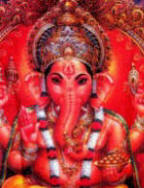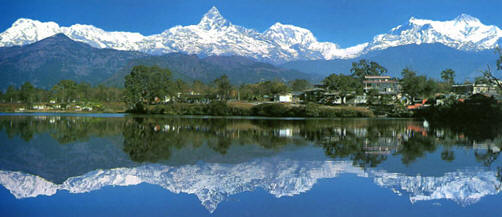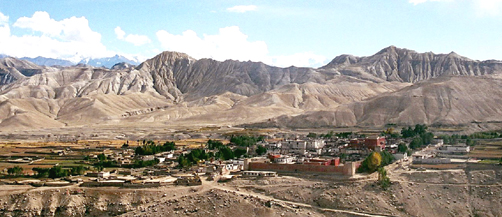 |
|
MO NEPALI SIKTSHOU |
|
J'apprends le
Népali |
Economy
The economy of Nepal east one of poorest and
of the least developed world, 42% of its population lives with the lower
part of the poverty line.
Agriculture is the principal sector of the
economy providing more than 80% of employment and accounting for 40% of the
GNP. The industrial activity consists mainly in the treatment of the
agricultural produce like the jute,
tobacco, the cane with sugar and cereals.
The international community takes part to a
total value of 60% of the budget of development of the country and to a
total value of 28% of the total budgetary expenditure. Nepal has a real
potential of development of the hydroelectric exploitation and tourism. But,
the developmental perspectives of other branches of industry are limited,
because of its technological delay, its geographical constraints and its
political instability.
Nepal is located on the southern slopes of
the Himalayas and presents itself as a narrow long strip of land 845 km of is in
west and broad from 145 to 241 km of north in the south. It is a small state of
147.181 km ² wedged between two giants and superpuissances, China in north and
India in the south. Its altitude varies
of 60 meters in Téraï with 8.848 meters with the
Mount Everest. This enormous uneven involves a very great diversity of grounds
and climates and consequently of the flora and fauna.
Geography
Nepal is divided geographically into several
parallel bands directed of the North-West towards south-east forming five great
natural areas:
Téraï, more in the south, of an average
altitude of 100 meters, is a zone of plains on the fertile alluvial ground,
belonging to the large plain of Gange in India.
Siwalik, located at the top of Téraï
culminating with 2.000 meters, penetrated by the virgin forest, it announces the
first tops.
Mahabharata Lekh, is a true assembly
line, whose certain tops reach 3.000 meters, with broad valleys and plates
sprinkled by the rivers come from the Himalayas.
The Nepalese plate, constitutes the
fourth and more important level, 100 km broad approximately, whose average
altitude is of 4.570 meters.
The Himalayan chain, eight of
the ten plus high summits of the world exceeding 8.000 meters.
NEPAL
Nepal is dominated by eight of the more high
summits of the world, surrounded of more than 100 tops of 7.000 meters
constituting a giant wall.
The Mount Everest, 8.848 meters, is the
culminating point of planet, overcome in 1953 by Sir Edmund Hillary and
Tenzing Norgay Sherpa.
It is called Sagarmatha by the Nepaleses
| Mont Everest |
8.848m |
1er
top of the world |
| Kanchenjunga |
8.586m |
3eme |
| Lhotse |
8.516m |
4eme |
| Makalu I |
8.462m |
5eme |
| Cho-Oyu |
8.201m |
6eme |
| Dhaulagiri I |
8.172m |
7eme |
| Manaslu |
8.156m |
8eme |
| Annapurna I |
8.091m |
10eme |
The Himalayas
term is the translation of two words Sanskrits, meaning
“the residence of snows”. |
Climate
Altitude constitutes an essential climatic
factor. In the high Himalayas, the temperatures remain cold all the year,
but the eternal snow does not go down in lower part 5.000 meters. All the
climates are present at Nepal, polar in high mountain, moderate on the
intermediate plates, of which the valley of Katmandu, and tropical in the
jungle of Téraï.
Nepal is subjected to the mode of the monsoon,
which goes up plain
of Gange to sprinkle the buttresses of the
Himalayas for three months,
from June to August. Precipitations depend on
altitude and the exposure of the reliefs to the rains of monsoon.
Teraï receives 2.000 mm of rain compared with
1.400 in Katmandu and 800 mm in the west of the country. Best seasons to go
to Nepal
are thus before and after monsoon in
April-May and October-November.
It is often forgotten, but Nepal east with
the latitude of Morocco and the Canaries and the climate remain moderate on
most of the territory..
Population
The population of Nepal is considered in 2004
at 27 million inhabitants, consisted of two principal groups: Indo-Nepaleses,
of Indian origin of religion hindouist and Tibéto-Nepaleses, origin tibéto-Burmese
of Buddhist religion. The majority of the
Nepaleses lives in Téraï (47%)
and on the Nepalese plate (45%), only 8% of
the population are dispersed in the mountainous sector highest.
Nepal forms a multiethnic and multicultural
company. The census of 2001 entered up to 103 different ethnicities.
source:
demographic statistics UNO (2001/2002 and 2004))
Demographic data
| population growth |
2,17% |
| Middle Age |
20,3
years (40%
of the population have less than 15 years) |
| life expectancy |
60,2
years |
| infant mortality |
65,3% (one
of highest of Asia) |
| |
1
woman out of 15 dies of the continuations of a pregnancy |
| rate of elimination of
illiteracy |
48,6%
(of which men 63% and women 37%) |
| schooling |
40%
of the children are provided education |
| access to drinking water |
88% of population
Pattern of the settlement
by religion
|
| Hindouisme |
80,6% |
| Bouddhisme |
10,7% |
| Islam |
4,2% |
| Kirant (religion des ethnies Raï,
Limbu et Sunuwar) |
3,6% |
| autres |
0,9% | |
| unumployment |
42% |
Hindouisme and
Buddhism are the two religions practised and omnipresent in the streets and the
campaigns of Nepal, where there exists a god for all things. The populations
Indo-Nepaleses are generally Hindu, whereas the populations Tibéto-Nepalese are
Buddhist.
The History does not mention any conflict between
these two religions whose rites are
similar and whose certain temples are divided between the two confessions.
The hindouists, accounting for 80% of the
population, also adopted many traditions local animists. During their
establishment in Nepal, the Indian populations founded their institutions, in
particular their system of castes.

Ganesh, wire of Shiva, are
the Master of all the
malfaisants spirits. It east is a god and very popular
and very venerated in Nepal.

Bouddha,
mean literally in
Sanskrit “which woke up”. The title of Buddha nominates a person having
carried out “the pure and perfect awakening”, having reached “the nirvana”.
There exists several Buddha, most known is the founder of Buddhism”
Siddhârta Gautama ", born in Nepal with Lumbini into 624 before JC and died
at the 80 years age into 544 before JC with Kusinagar in India (Uttar
Pradesh).
|
Climatology :
Median values |
|
Katmandou |
janv. |
fév. |
mars |
april |
may |
june |
july |
august |
sept. |
oct. |
nov. |
dec. |
|
Pluviometry (mm) |
15 |
41 |
23 |
58 |
122 |
246 |
373 |
345 |
155 |
38 |
8 |
13 |
|
Temperature maxi (°C) |
18 |
19 |
25 |
28 |
30 |
29 |
29 |
28 |
28 |
27 |
23 |
19 |
|
Temperature mini
(°C) |
2 |
4 |
7 |
12 |
16 |
19 |
20 |
20 |
19 |
13 |
7 |
3 |
Flora and fauna
Altitude also influences the flora in its
diversity. Although the Nepalese territory is not very wide, all the
climatic modes are represented there, giving rise to an exuberant and
exceptionally diversified flora. One does not count less than 6.500 species
of trees, shrubs and wild flowers in Nepal. The tropical forests of altitude
push up to 2.000 meters, then yield the place to the forests of
Rhododendrons and leafy trees up to 3.000 meters and with the forests of
pines, oaks and fir trees up to 3.900 meters. Beyond that, only one close-cropped
vegetation remains.
Nepal shelters also a very large variety of
mammals, birds and reptiles. Tigers, leopards, elephants, rhinoceroses live
in the wetlands of Téraï, goat's milk cheeses, sheep wild, wolf, bear and
yaks populates the mountainous slopes. Eight national parks and four natural
reserves covering more than 8% of the entire surface of the country, were
created to protect these threatened species.
Katmandu
capital of Nepal was founded in Xème
century by king Gunakamadeva. The city is located at 1350
meters of altitude, with the confluence of two rivers, Bagmati and Bishnumati,
in the middle of a vast valley surrounded of the first Himalayan mountains,
including/understanding 3 royal cities: Katmandu, Patan and Baktapur.
The valley of Katmandu counts 2700 temples and
monuments: polychrome carved wood, red brick, copper roofs, pagodas and stupas
give
the tone with the whole landscape. Seven sites
are registered with the world heritage
UNESCO.
As much of poor towns of country, Katmandu is
divided today between tradition and modernity. In spite of a fast and
anarchistic urban growth, Katmandu remains an attaching place
where the history left many testimonys.
In 2007, the population of town of Katmandu is
estimated at 856.000 individuals. The last official census of 2001 entered
671.846 inhabitants
 Annapurna massif seen of the lake
Phewa Tal in Pokhara
Annapurna massif seen of the lake
Phewa Tal in Pokhara

Lo Manthang, strengthened capital
of the old kingdom of Mustang
Devanagari,
mean in Sanskrit
“divine writing”. Alphabet spelling-book
used to write, inter alia,
Sanskrit, the Hindi, the
Nepalese, the marathe and several other languagesIndians. It descends from
the writing “brâhmî” nd
is at the origin of the writing Tibetan.
Language
The official language of the country is the
népali, pertaining to the European indo family and of Indo-Iranian group.
But Nepal counts more than one hundred of language: 93 languages
sino-Tibetans, against 26 Iranian languages indo. However, the 26
Indo-Iranian languages gather
86% of the speakers compared with 13% for the
languages sino-Tibetans.
Two languages of the austro-Asian family and
a language of the dravidienne family, gather 1% speakers.
|